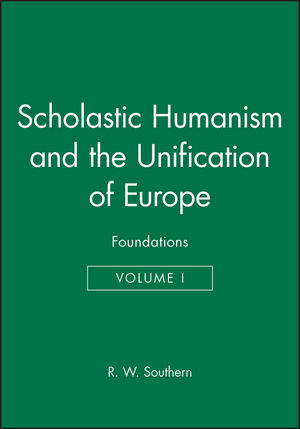Scholastic Humanism and the Unification of Europe, Volume I: FoundationsISBN: 978-0-631-20527-2
Paperback
368 pages
July 1997, Wiley-Blackwell
 |
||||||
List of Maps and Plates.
Abbreviations and Short Titles.
Two Preliminary Maps.
Introduction.
PART ONE – AIMS, METHODS, AND ENVIRONMENT.
1 Scholastic Humanism.
I Contrasting types of humanism.
II Characteristic features of scholastic humanism.
III The problem of the natural sciences.
IV Summits of success.
V The regulation of social life.
VI The loss of hope.
2 Chartrian Humanism: A Romantic Misconception.
I Introduction.
II Humanism and the School of Chartres.
III Replies to critics.
3 The Sovereign Textbook of the Schools: The Bible.
I The qualities of the Bible in scholastic thought.
II Methods of investigation.
III Bringing the message of the schools to the world.
4 Social and Political Roots of Scholastic Thought.
I Pre-scholastic and scholastic Europe.
II The new symbiosis of schools and government.
III The schools, society and the individual.
IV The schools and the papacy.
5 The Men and Their Rewards.
I Scholars of the world.
II Ancients and Moderns.
III The new age.
IV The glory and gossip of the schools.
6 The Scholastic Metropolis of Northern Europe.
I Old institutions: new needs.
II Stages in the triumph of Paris.
III Conclusion.
IV Appendix – A schedule of Parisian masters.
PART TWO – TURNING DOCTRINE INTO LAW.
7 The Outlook in Northern Europe.
I Truth and truth-enforcement.
II Law and society in northern Europe.
III Summits of northern European legal scholarship, c. 1050–1120.
IV Federalism v. centralization.
8 The Outlook in Northern Italy.
I Cultural potentialities and limitations.
II Irnerius and the menace of Roman law.
9 The Integration of Doctrine and Law: Gratian.
I Demand and response.
II The man and his work.
III The originality of his work.
IV Method of work and date of compilation.
V Gratian’s change of mind about Roman law.
VI The personality behind the work.
VII Did Gratian teach canon law?
VIII The first masterpiece of scholastic humanism.
IX Time and Place reviewed.
Index.



